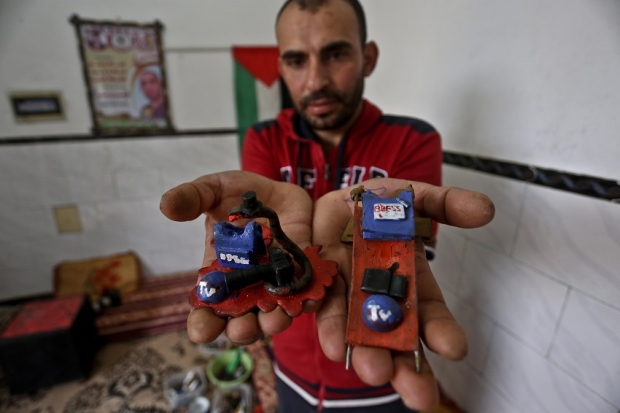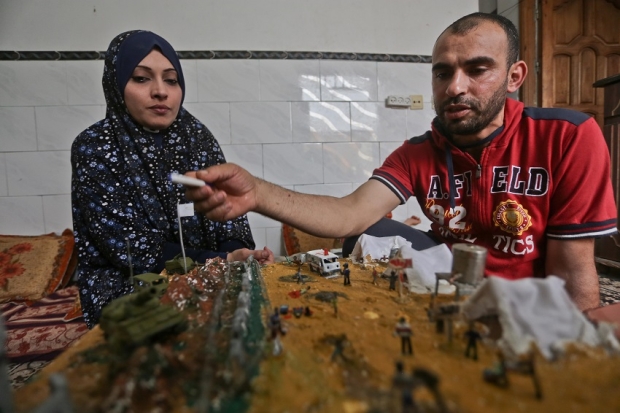Bullets and Shrapnel: Meet the Gaza artist turning weapons into art

GAZA STRIP - On any given day, Majdi Abu Taqqeyeh can be found scouring the border between Gaza and Israel, collecting remnants of Israeli bullets.
Israeli shrapnel, empty tear gas canisters, and even extracted bullets from the bodies of injured Palestinians obtained at Gaza's hospitals are part of his memorabilia.
It is a habit that he developed in 1991, during the first Palestinian Intifada.
An homage to the Great March of Return
On 30 March, Palestinians started a 46-day mass protest to demand their right of return to their homes in historic Palestine. It was set to end on 15 May, the 70th anniversary of the Palestinian Nakba (the Catastrophe), when more than 750,000 Palestinians were forcibly displaced by Israeli forces in the wake of Israel's establishment in May 1948.
According to the latest figures released by Gaza’s health ministry, at least 115 protesters have been killed during the protests, with hundreds more still in hospital with serious injuries.
A journalist, an artist, a painter, every person has a message they are spending their lives spreading …The story of the Great March will be inherited, it won’t die
- Abu Taqqeyeh, artist
Rights groups have said that Israel is carrying out a policy of deliberately targeting protesters with live fire and using "excessive and lethal force". The Israeli army insists its actions are necessary to defend the frontier between Israel and Gaza and prevent mass infiltrations.
Rights groups, however, said that many of the people who were killed were nowhere near the fence that Israel had erected on Palestinian territory in Gaza.
On Thursday, Israel’s Supreme Court unanimously dismissed a petition by two human rights groups accusing Israel of violating the law by using snipers and live ammunition against peaceful Palestinian protesters in Gaza.
Abu Taqqeyeh took the bullet extracted from his brother’s leg from the doctor and sculptured it into a miniature Canaanite soldier.
“Canaanites are our ancestors. They were the first people who came to Palestine. The figure of the Canaanite soldier demonstrates that we have the right to live on this land,” he says.
The Canaanites inhabited the Levant region, including ancient Palestine, thousands of years ago and were believed to have been wiped out by the Israelites according to Old Testament scripture. However, a recent genetic study suggested that the ancient population survived, and their descendants live in modern Lebanon.
“I transformed these violent weapons into peaceful handmade figurines and miniature installations,” he says.
For Abu Taqqeyeh, these miniature sculptures are a testament to the aggressions committed by Israelis against Palestinians living under occupation and an Israeli-imposed siege.
Labour of love
The 38-year-old retired father of three and former marine first started drawing with coal when he was 13 years old. At the age of 15, he started carving wood.
One of his sculptures is a Palestinian map, with the Dome of the Rock etched in the centre and a key wrapped in barbed wire.
The piece, which took Abu Taqqeyeh 48 hours to make, is meant to symbolise the Israeli occupation. Abu Taqqeyeh says that when he starts working on a piece, he doesn’t rest until it is done. He is hoping one day to open his own exhibition to demonstrate the reality of the Palestinian struggle.
“This is a message to the world; that Palestinians love life,” he says.
This is a message to the world; that Palestinians love life
- Abu Taqqeyeh, artist
Despite the harsh economic conditions he faces, Abu Taqqeyeh is not interested in making any profit from his handmade crafts. Instead of selling them, he gives them away as souvenirs to people who visit Gaza.
Abu Taqqeyeh says the collectables look ugly when he first gathers them and places them on his shelves; but after working on them, they are transformed into beautiful miniature figures.
The process is laborious and every object is different. He first heats the bullet casing on a stovetop, to make it easier for him to mould. When the object is warm enough, he flattens it with a hammer, then uses a nail file, blades and other tools to sculpt and perfect it. The finishing touches usually incorporate oil paint.
It took Abu Taqqeyeh two days, with no sleep, to complete this piece, which includes a stretcher, a helmet and a vest that reads "Press," in reference to the targeting of journalists at the protests.
The installation also includes a boy who was shot in both of his legs, waving a kite adorned with the colours of the Palestinian flag, in addition to protesters pulling on the barbed wire Israeli forces put in place near the border fence separating Gaza and Israel.
Occupational hazards
His art, however, comes with some occupational hazards. Abu Taqqeyeh sustained an injury after a bullet he had collected on the second Friday of the Great Return March protests exploded in his hand as he was heating it, wounding his fingers. Abu Taqeyyeh takes precautions to make sure the bullet casings are empty before working on them, but sometimes remnants of the bullets remain inside.
It can cost me my life when I collect these bullets near the fence
- Abu Taqqeyeh, artist
”It can cost me my life when I collect these bullets near the fence,” he says, referring to the risky journeys he makes so that he can collect the battle remains near the borders.“Whoever goes near the border fence is targeted,” he explains.
Still, he believes that “a person who has a message to the world has to sacrifice his life to spread his message".
One of his art pieces is a sculptured bullet, with a pigeon escaping from it, to convey Palestinians longing for peace.
‘I feel so proud’
His 30-year-old wife Walaa helps Abu Taqqeyeh both with ideas and by painting the figures. He also taught her how to use nail files and blades that he uses for sculpting.
“My wife helps me a lot. She always makes me feel relaxed," Abu Taqqeyeh says.
Through his hobby, Abu Taqqeyeh says he is able to describe every small detail of the current situation and he believes he is creating small monuments. Among Abu Taqqeyeh's work is an Israeli sniper, Israeli jeeps and an Israeli flag to demonstrate the occupation.
To nurture his hobby further, Abu Taqqeyeh needs to buy a micro firesteel, original ceramic clay, and high quality colours – tools he says he cannot afford due to the devastating economic situation imposed by the blockade.
“I can barely afford the essential needs and the rent for my family,” he laments.
Abu Taqqeyeh is one of 6,000 Palestinian civil servants in Gaza who were forced into early retirement by the Fatah-run Palestine Authority in 2017.
For his next project, Abu Taqqeyeh and Walaa are going to create the Rafah border crossing to demonstrate the suffering of Palestinians because of their lack of freedom of movement.
The Rafah crossing is the only gateway not controlled by Israel, for the nearly 2 million Palestinians trapped in Gaza under an 11-year siege imposed by Israel. The border crossing maintained by Egypt is opened temporarily a few times a year for humanitarian cases. Tens of thousands of Palestinians, such as study abroad students, or patients in need of medical attention, gather at the border each time, hoping for a chance to leave.
”A journalist, an artist, a painter, every person has a message they are spending their lives spreading,” he continues. “If I die, my message will never die. The story of the Great March will be inherited, it won’t die,” Abu Taqqeyeh says.
Middle East Eye propose une couverture et une analyse indépendantes et incomparables du Moyen-Orient, de l’Afrique du Nord et d’autres régions du monde. Pour en savoir plus sur la reprise de ce contenu et les frais qui s’appliquent, veuillez remplir ce formulaire [en anglais]. Pour en savoir plus sur MEE, cliquez ici [en anglais].









